If your development team is moving fast but still missing deadlines, unclear on what to build, or rebuilding features twice — you’re not just short on software requirement specification. You’re short on clarity.
That’s where a dedicated Business Analyst (BA) comes in. BAs bridge the gap between business vision and development execution. They challenge assumptions, define logic, own business requirements, and connect disconnected stakeholders.
This article walks through 10 real-world signals we’ve seen across dozens of projects, including:
1) You have designs, but no requirements
2) No one owns end-to-end user flows
3) Priorities change weekly — and no one asks why
4) You have a massive backlog and no prioritization logic
5) Everyone has a different definition of “done”
6) Developers keep asking “What does this mean?” — mid-sprint
7) Roadmap changed — but the tickets didn’t
8) You’re working across time zones or external vendors
9) No user research, no validation — just another MVP rewrite
10) Your PM or dev is playing BA — and burning out
If you recognize even a few, don’t ignore them.
Business analysis is not just gathering requirements

If you think a Business Analyst is someone who “just writes down what stakeholders say,” you’ve worked with the wrong one.
In high-stakes software projects — especially those with complex integrations, multiple user types, or shifting business models — a BA is the strategic layer between vision and execution. Their role isn’t to document what’s already known. It’s to uncover what’s missing, align what’s miscommunicated, and de-risk what’s assumed.
What a dedicated BA does that hybrid roles don’t:
- Neutral facilitation — Unlike a project manager or stakeholder with skin in the game, a BA can challenge assumptions without bias.
- Clarity from ambiguity — Vague goals? Conflicting KPIs? The BA’s job is to make business logic executable.
- System-level thinking — A good BA understands tech, business, and UX. A great one connects them all.
At Volpis, our BAs often step in when a project’s already gone sideways — unclear scope, constant rewrites, or mismatched expectations between teams. But brought in early, they prevent those breakdowns entirely.
This isn’t about documentation. Business Analyst creates shared understanding: framing needs, context, and value to help clients and teams align — and move fast in the right direction.
10 high-stakes warning signs project needs dedicated business analyst, now

Let’s take a closer look at signs your software development project urgently needs a dedicated business analyst before it goes off the rails:
1) You have designs, but no technical requirements
You’ve got a polished UI in Figma, but no one’s sure how it actually works. There’s no documented logic, no validation rules, and no clear user flows. Developers are left to interpret screen designs on their own, and each person interprets them differently.
What this costs you:
Misunderstandings. Rework. UI that looks great but breaks under real user scenarios. Features get implemented with missing states, skipped edge cases, or backend behavior that doesn’t match the visual intent, or the business need behind it

How a BA solves it:
A Business Analyst defines not just how features work, but why they matter. They connect each screen to business goals and user needs, clarify how functionality supports real processes, and ensure logic, flows, and rules are documented and buildable. With a BA in place, Figma stops being the spec — and starts being just one part of a complete, buildable plan.

2) No one from your dedicated software development team owns end-to-end user flows
Design owns the screens. Developers own the logic. QA owns testing. But no one owns the full experience. Users fall through cracks, especially across roles, steps, or platforms.
What this costs you:
The product “works” technically, but fails functionally. Confusing flows, duplicate logic, and missed validations frustrate users, slow adoption, and reduce the overall value delivered to the business.

How a BA solves it:
BAs own the full narrative. They map journeys, visualize decision points, and connect logic across departments, making sure each step supports both user needs and business goals. At Volpis, this has been key for fleet apps where drivers, dispatchers, and admins follow interdependent workflows.
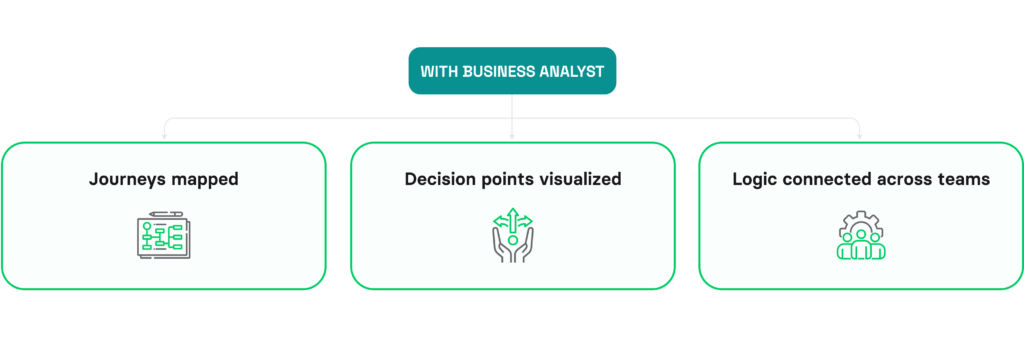
3) Priorities change weekly, and no one asks why
Every week, someone shifts the plan. Sales wants a feature for a key client. Marketing demands a dashboard tweak. Leadership introduces a new metric. The development team nods, adjusts, and rushes forward — without ever asking: does this align with our product goals?
What this costs you:
Chaotic delivery. A roadmap that’s reactive, not strategic. Features that satisfy no one fully. And a product that feels like a collection of knee-jerk decisions, not a vision-driven platform.
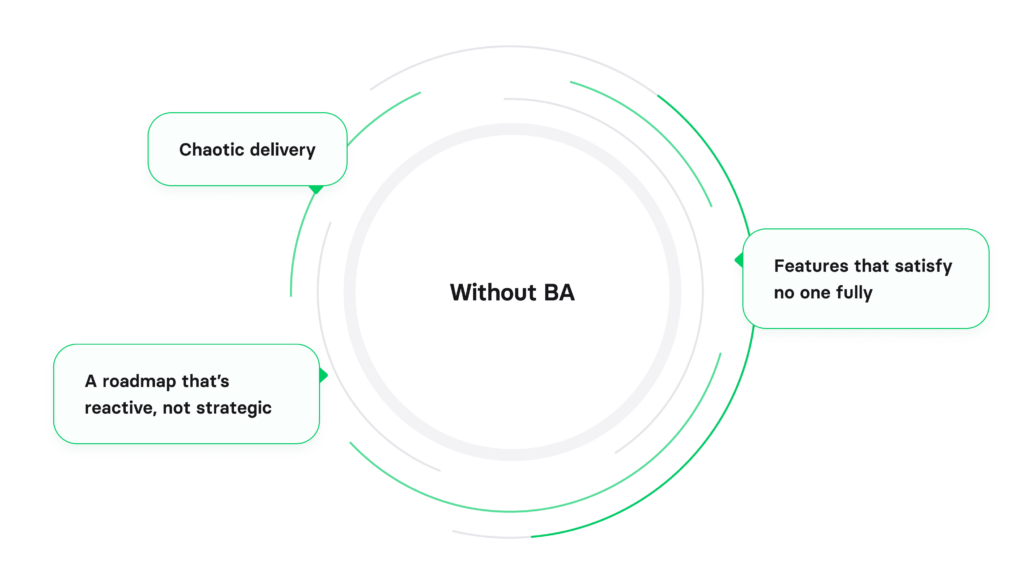
How a BA solves it:
A BA can bring discipline to product planning and establish clear communication protocols. Business Analyst works to frame requests in terms of business value and user need. When priorities change, BA asks why — and evaluates what’s impacted. With a business analyst in the room, your roadmap gets filtered, not flooded.

4) You have a massive backlog of complex projects and no prioritization logic
Your backlog keeps growing, but no one can explain what actually matters. Everything is marked high priority. Stakeholders argue over pet features. Developers pull random tickets.
What this costs you:
You build what’s loudest, not what’s most valuable. Critical features get buried. Team morale drops when effort doesn’t equal progress.

How a BA solves it:
A BA brings prioritization logic to the chaos. They map features to business goals, user pain points, and technical feasibility. With a BA, your backlog becomes a roadmap, not a wishlist.

5) Everyone has a different definition of “done”
Design thinks it’s done when the UI looks good. Dev thinks it’s done when it doesn’t break. QA thinks it’s done when test cases pass. Stakeholders think it’s done when it solves a business problem. But no one agrees.
What this costs you:
Misalignment, endless revisions, and frustrated teams. “Done” becomes debatable, and deadlines don’t stick.

How a BA solves it:
A BA defines acceptance criteria before work begins. They align expectations across roles, ensuring everyone builds toward the same outcome.

6) Developers keep asking “What does this mean?” — mid-sprint
Tickets are written, but developers are still confused, asking basic clarification questions during the sprint. PMs scramble to unblock. QA loses test confidence.
What this costs you:
Lost momentum and increased stress. Tight deadlines and delays. Rework. Frustrated engineers doing requirements gathering work on the fly.
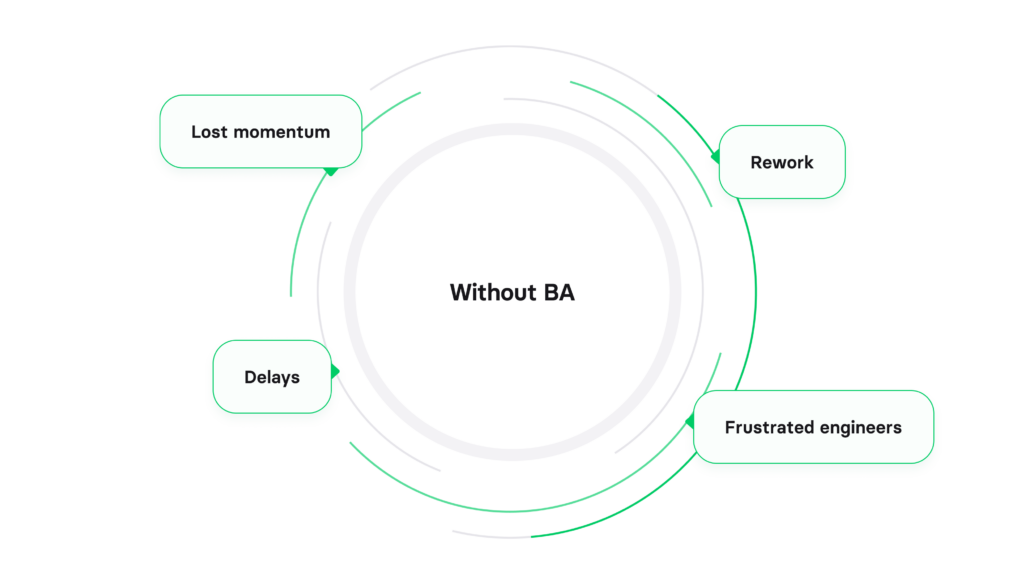
How a BA solves it:
BAs write complete, validated user stories with acceptance criteria. They define logic, edge cases, and what success looks like — before dev starts. The result: cleaner sprints, fewer blockers.

7) Roadmap changed — but the tickets with development tasks didn’t
Leadership updates strategy. The market shifts. You’re targeting a new persona. But your backlog still reflects last quarter’s goals.
What this costs you:
Wasted effort. Misaligned product features. Lost time building for the wrong context.
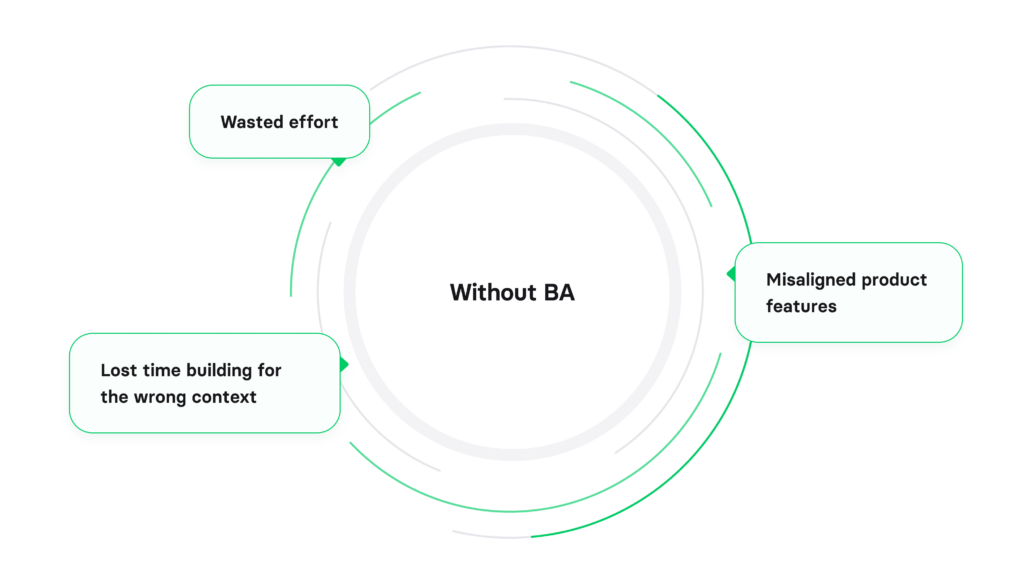
How a BA solves it:
A BA ensures requirements evolve with strategy. They revisit scope, update assumptions, and connect product work to real business shifts.

8) You’re working across time zones or external vendors
Your dev team is in Eastern Europe, design is in-house, and the client sits in Chicago. Misalignment multiplies: decisions get delayed, go undocumented, and teams build without a clear, shared direction.
What this costs you:
Communication gaps lead to inconsistent outputs, duplicate work, and rework that drains both time and budget.

How a BA solves it:
A BA acts as a single point of alignment — maintaining updated documentation, decision logs, and clarity across time zones. At Volpis, our BAs often lead async-first workflows that keep momentum alive even when teams are 10 hours apart.

9) No user research, no validation — just another MVP rewrite
You shipped the MVP. It flopped. Now you’re rebuilding without validating why it failed. The same assumptions are driving v2.
What this costs you:
Another failed launch. Wasted money. Damaged team confidence. And still no clarity.

How a BA solves it:
BAs challenge assumptions with real data. They do stakeholder interviews, analyze usage, and pressure-test logic — before the next sprint begins.

10) Your PM or dev is playing BA — and burning out
Your PM is trying to define user flows between standups. Developers are asking clients for requirements. No one was hired for this, but they’re doing it anyway.
What it costs you:
Inconsistent quality. Burnout. Delivery bottlenecks. Hidden scope creep.
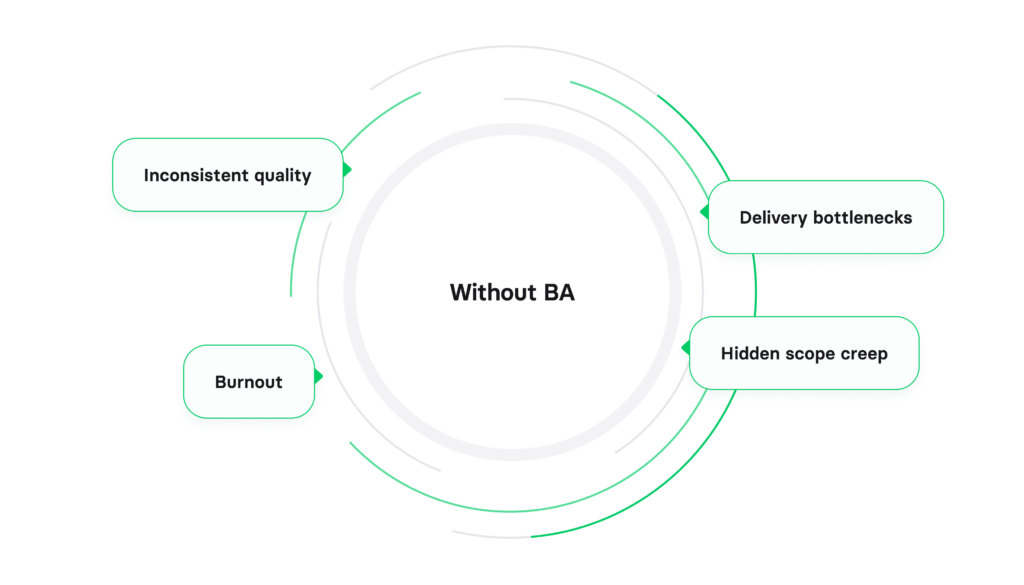
How a BA fixes it:
A dedicated BA takes that hidden load off your team. They own the complexity, define the logic, and give PMs and devs space to do what they do best.

What to do if these signs sound familiar
You don’t need a full-time BA from day one. But if you recognized 3 or more of these signs, you’re already paying the cost in lost time, misalignment, and rework.
Start simple: audit your backlog, run a discovery sprint, or bring in a BA for just one flow. The ROI is fast and measurable.
At Volpis, we help product teams move from chaos to clarity with embedded Business Analysts who eliminate ambiguity, define priorities, and bring structure to fast-moving projects.
Let’s fix the friction.
Regularly ranked among the top custom software development companies on Clutch, Volpis leverages the expertise of our BA team to help business owners achieve unparalleled milestones. We invite you to explore our portfolio for a detailed look at the innovative software solutions we have developed for our cherished clients.
Read more reviews from our valuable customers here
We’d love to answer any questions you may have about business analysis during the software development process. You can always connect with us via info@volpis.com to clarify any concerns or to explore how we can be part of your journey.
Let’s build your software with a clear roadmap
Our business analysts will help you define requirements, validate ideas, and make your project a total win!
FAQ
The Product Manager acts as the visionary for the product, akin to a movie director, ensuring the product meets market and stakeholder needs. They conduct market research, analyze industry trends, and define the product’s direction and strategy, including the go-to-market plan. The Business Analyst, on the other hand, is the problem solver and facilitator, bridging the gap between users, stakeholders, and the Agile team. BAs question assumptions, assess needs, and work closely with the Product Owner to detail user stories and business requirements. They often act as a Proxy Product Owner to provide direct access to the PO’s insights.
Before. Design needs logic. A BA identifies core flows, user roles, dependencies, and edge cases that shape design decisions. Skip this step and you’ll likely redesign later — not because of visuals, but broken business logic.
Yes. A BA can triage unclear tickets, align teams, and stop rework mid-flight. We’ve joined projects post-MVP to untangle poor documentation and clarify misunderstood logic — and turned chaos into consistent delivery.
Yes. BAs assess feature complexity, dependencies, and business value. They help identify low-effort, high-impact wins and deprioritize noise — so you invest in what actually drives outcomes, not just what’s loudest.
Not always. MVPs or focused features may only need part-time BA support. But products with multiple roles, integrations, or scaling plans usually benefit from ongoing BA involvement. You can read more about it in our recent guide on business analysis in software development.
Business analysts act as a bridge between the current team and stakeholders, ensuring clear, consistent, and effective communication. They apply a pragmatic approach to analyzing requirements and identifying gaps, helping the management team define a realistic project scope. Their technical expertise empowers business users and improves decision making. This not only increases productivity but also enhances client satisfaction across the development lifecycle.
How can a business analyst support an in-house team during complex projects that require specialized skills?
A business analyst plays a key role in helping the in house team manage various tasks by creating a clear work breakdown structure. For complex projects, they interpret data and align internal resources with project goals, ensuring efficient collaboration. When the project requires specialized skills not present in the existing team, the BA helps identify skill gaps and supports a smoother onboarding process. This approach gives the client’s project a competitive edge while maintaining momentum and focus.
Business analysts help the team navigate change management by translating shifting requirements into actionable tasks. They collaborate closely with the existing team to ensure the onboarding process for any new skilled talent is seamless and supports the desired outcomes. By focusing on both user needs and business objectives, BAs shape the final product to enhance the overall user experience. Their ability to coordinate internal resources and manage team size effectively makes them essential to project success.

Kostya Khuta, the CEO of Volpis, is an expert in crafting custom software solutions for the Fleet Management, Logistics, and Transportation industry. With over 8 years of experience, he leads the way in delivering innovative and tailored solutions to meet industry-specific needs.





